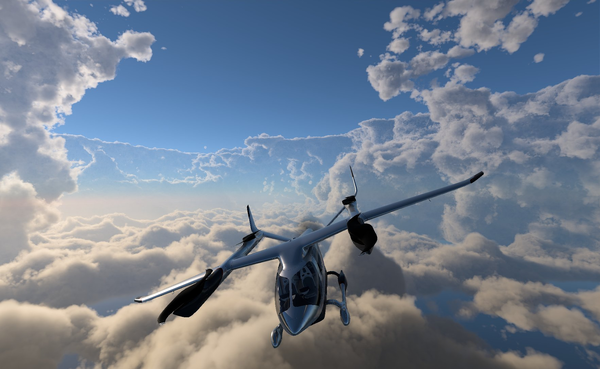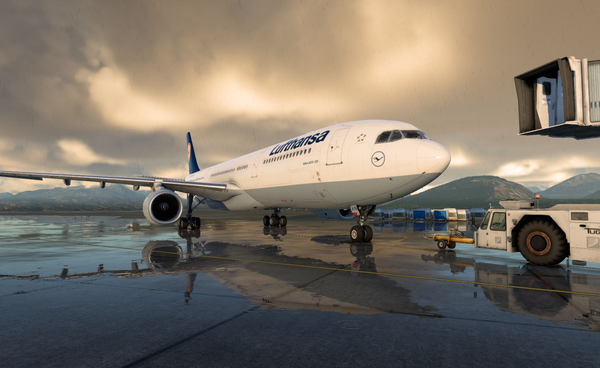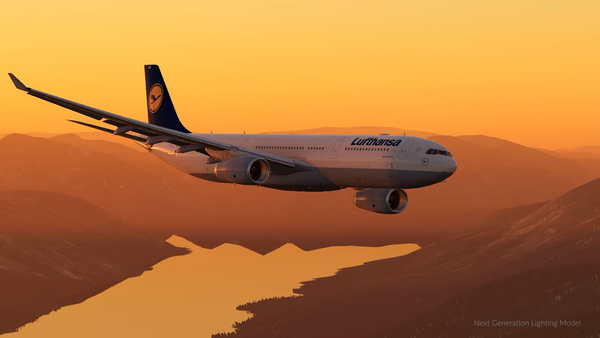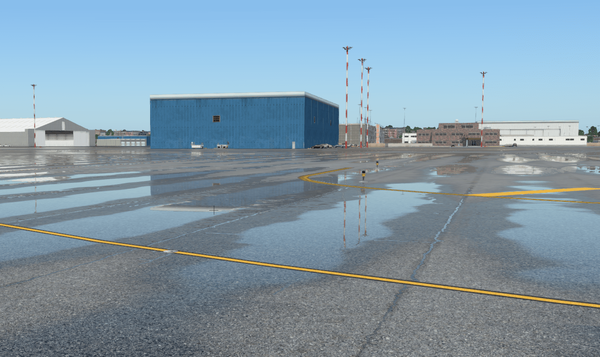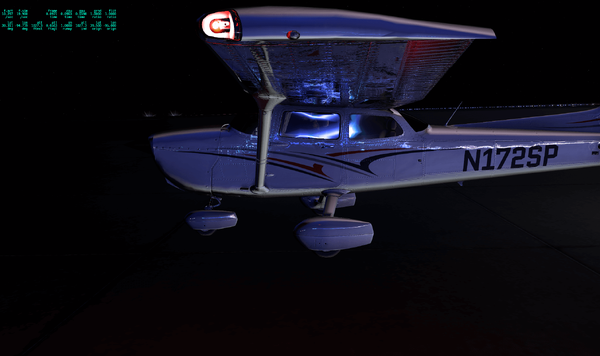X-Plane 12
This article documents announced, but not yet publicly released simulator content. Information may change rapidly as new data is discovered and initial reports should be treated as unreliable. The latest updates to this article may not reflect the most current information. |
X-Plane 12 is an upcoming professional flight simulator that is being developed by Laminar Research and published by Laminar Research. X-Plane 12 was announced on September 25th, 2021 at the FlightSimExpo 2021.
X-Plane 12 entered private alpha on 2021-12-03 and its public beta, titled Early Access, on 2022-09-05. Patch notes are available for each release version. It is forecasted to release in December 2022.
Summary
X-Plane 12 features an updated cloud system, updated water system that now includes waves in 3D, updated ambient sound engine (you will hear wind, rain, thunder, cars and birds), updated autogen engine (for buildings and seaports), updated 3D forest engine to integrate Seasons. For developers X-Plane 12 supports FMOD 2.0 which will be easier for third-party developers and sound designers.
Aircraft
The simulator includes several aircraft spanning a variety of types and sizes with the base installation at no additional charge.
- Aero-Works Aerolite 103
- Airbus A330-300
- Beechcraft Baron 58
- Beechcraft King Air C90B
- Boeing 737-800
- Cessna 172SP Skyhawk
- Cessna 172SP Skyhawk (G1000)
- Cessna 172SP Skyhawk (floats)
- Cessna Citation X
- Cirrus SR22
- Cirrus Vision SF50
- Grumman F-14D Super Tomcat
- Lancair Evolution EVOT-850
- McDonnell Douglas F-4 Phantom II
- McDonnell Douglas MD-82
- Piper PA-18-150 Super Cub
- Robinson R22 Beta II
- Robinson R22 Beta II (floats)
- Schleicher ASK 21
- Sikorsky S-76C
- Stinson L-5 Sentinel
- Van's Aircraft RV-10
- Beta ALIA-250 note: unconfirmed
Additional aircraft are available either as payware from the official distributor (Aerosoft), as 3rd party installs purchasable from numerous online retailers, or as free content mostly available from X-Plane.org.
For a list of aircraft available for the simulator with articles, see available airplanes in X-Plane 12 and available helicopters in X-Plane 12.
Airbus A330 inclusion
The Airbus A330 will be the first included heavy aircraft in many years. It will no longer use crank-and-pulley flight systems which allowed for extreme maneuvers with direct, unfiltered input from the user. Instead adopting a full fly-by-wire architecture, the A330 will respect all of the normal law limitations inherent to Airbus design and intervene to preventing excessing G-loading, overbank, pitch outside of design parameters, and overspeed conditions just as the real aircraft would. The aircraft also includes an auto-throttle system complete with the expected thrust modes such as Take-Off/Go-Around (TOGA), Flexible Temperature (FLEX), Maximum Continuous Thrust (MCT), and Maximum Climb Thrust (MCL). The model features extensive detail to the exterior and a fully-detailed cabin.[1]
The hydraulic system will simulate all of the components installed in the real aircraft to include the 7 pumps fitted across 3 hydraulic loops — green, blue, yellow. Failure in any primary loop will cause realistic reversion to the backup loop; loss of pressure in both primary and secondary loops will cause control system losses. The Electronic Centralized Aircraft Monitor (ECAM) warning guidance system will recognize failures and provide the crew checklists to remedy the issue. The secondary display page (central bottom display unit) will automatically display the appropriate page for the current phase of flight such as APU start, engine start, cruise, and landing.[2]
The main landing gear received special attention in that the non-linear strut compression has been modeled to account for the additional downforce which occurs during early takeoff due to the "eagle claw's" rotation.[3]
Weather
The weather system has been overhauled from the ground up. Instead of downloading a large number of METARs local to airports, this version of the simulator will use centrally-processed NOAA GLIB files from a Laminar Research central server which span the globe. This change will transition the simulator from a current slice-of-time approach using hourly reports to a forward-looking method based on algorithmic predictions. This change is expected to greatly decrease the granularity of data, improve real-time meteorological information in less traditionally underserved areas, and allowing for smoother real-time weather transitions in-flight.[4]
In previous versions of the sim, clouds were rendered as 2D objects and to simulate 3D effects many of these objects would be drawn simultaneously at the cost of simulator performance. X-Plane 12 will instead feature volumetric clouds using raymarching to render cloud boundaries and calculate the position/effect of individual water droplet clusters.[5]
The scenery engine has been upgraded to dynamically display water and snow coverage on ground surfaces. Scenery authors will be able to specify desired locations for both puddles and snow banks/drifts by defining weather masks within their packages.[6]
Noting the popularity of the third-party librain plugin to simulate rainfall on aircraft windscreens, the developers have implemented the plugin into the simulation engine. By doing so, the plugin gains access to flight model data such as propwash, jetwash, downwash, and windshadow which it can then natively use to increase performance and simulate accurate refractions in each droplet.[7]
Lighting
The lighting system is being reworked to include photometrics. The engine will be able to handle specifying the brightness of a light source either at the individual bulb level (as is common for aircraft) or as measured from outside of the lens covering the bulb (as is common for airports). Overall night lighting levels for airports has been reduced significantly to allow for more realistic dark surroundings to runways and taxiways. The direction of airport lighting is also being considered so that airports appear more akin to an "inky black void" when viewed from airliner cruise altitudes.[8]
The defrosting system for windows is being updated to allow developers to specify the pattern for how a windscreen should defrost. This will allow, for example, windscreens to defrost fastest near defrosting vents. Water is also being rendered differently from land and the atmospheric scattering is properly accounted for.[8]
Supported peripherals
- Thrustmaster TCA Sidestick Airbus Edition
- Thrustmaster TCA Quadrant Airbus Edition
- Additional supported peripherals TBA
System Requirements
PC
| Minumum | Recommended | |
|---|---|---|
| OS | Windows 10 or 11, 64-bit macOS 10.15 or newer (e.g., Catalina, Big Sur, Monterey) | |
| Processor | Intel Core i3, i5, i7, or i9 CPU (4 or more cores), or AMD Ryzen 3, 5, 7 or 9. | Intel Core i5 8600k or Ryzen 5 3500 or better, or Apple Silicon |
| Graphics card | NVIDIA: GeForce 900 series or newer (desktop) NVIDIA: GeForce 965M, 970M, 980M, and 980MX or newer (2nd gen Maxwell) (laptop) AMD: Radeon RX 500 or newer Apple: Silicon |
GeForce GTX 1070 or better, or similar from AMD, w/4 GB VRAM |
| RAM | 8 GB RAM | 16-24 GB RAM or more |
| HDD Space | TBA | TBA |
| DirectX | Version 11 | Version 12 |
Gallery
Development screenshots
Development videos
- X-Plane 12 – Official Trailer
- X-Plane 12 - Airport and Environment Previews
- X-Plane Fleet Preview One
- X-Plane Technology Preview One
- X-Plane Next Generation Forestry Preview
- X-Plane 12 - Aircraft- Airbus A330
- X-Plane 12 - Aircraft- Cirrus
- X-Plane 12 - Aircraft Preview- EVO
- X-Plane 12 - New ATC
- X-Plane 12 - Aircraft Preview- Citation
- X-Plane 12 - Autogen and Water Previews
References
- ↑ X-Plane 12 Announcement Keynote4. YouTube. 2021-09-25 (published 2021-09-27). Timestamp 9:58. https://www.youtube.com/watch?v=MnQxD1Y_N0w. Retrieved 2021-10-08.
- ↑ X-Plane 12 Announcement Keynote6. YouTube. 2021-09-25 (published 2021-09-27). Timestamp 11:42. https://www.youtube.com/watch?v=MnQxD1Y_N0w. Retrieved 2021-10-08.
- ↑ X-Plane 12 Announcement Keynote6. YouTube. 2021-09-25 (published 2021-09-27). Timestamp 13:12. https://www.youtube.com/watch?v=MnQxD1Y_N0w. Retrieved 2021-10-08.
- ↑ X-Plane 12 Announcement Keynote. YouTube. 2021-09-25 (published 2021-09-27). Timestamp 1:48. https://www.youtube.com/watch?v=MnQxD1Y_N0w. Retrieved 2021-10-08.
- ↑ X-Plane 12 Announcement Keynote. YouTube. 2021-09-25 (published 2021-09-27). Timestamp 6:57. https://www.youtube.com/watch?v=MnQxD1Y_N0w. Retrieved 2021-10-08.
- ↑ X-Plane 12 Announcement Keynote. YouTube. 2021-09-25 (published 2021-09-27). Timestamp 8:21. https://www.youtube.com/watch?v=MnQxD1Y_N0w. Retrieved 2021-10-08.
- ↑ X-Plane 12 Announcement Keynote4. YouTube. 2021-09-25 (published 2021-09-27). Timestamp 9:01. https://www.youtube.com/watch?v=MnQxD1Y_N0w. Retrieved 2021-10-08.
- ↑ 8.0 8.1 Free Form Friday: Lights, Water, Frost. Laminar Research Developer Blog (2021-10-29). Retrieved on 2021-10-31.


